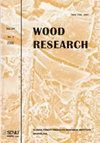木材解剖特征与表面粗糙度特征的关系
IF 1
4区 农林科学
Q3 MATERIALS SCIENCE, PAPER & WOOD
引用次数: 0
摘要
本研究旨在研究15种不同板材的表面粗糙度与木材解剖特征之间的关系。使用表面轮廓仪平行和垂直于木纹测量表面粗糙度,并使用显微镜技术分析孔径和分布等解剖特征。结果表明,对于所有木材样品,垂直于颗粒方向的表面粗糙度始终高于平行于颗粒方向。这种粗糙度的差异与孔径和密度有关。结果表明,较大的孔隙和较低的密度导致垂直于晶粒的粗糙度较高。研究还发现,传统的手工规划方法(推拉)可以产生光滑的表面光洁度,粗糙度没有统计差异。本文章由计算机程序翻译,如有差异,请以英文原文为准。
RELATIONSHIP BETWEEN WOOD ANATOMICAL FEATURES AND SURFACE ROUGHNESS CHARACTERISTICS
This study aimed to investigate the relationship between surface roughness and anatomical features of wood in 15 different species of boards. Surface roughness was measured parallel and perpendicular to the wood grain using a surface profilometer, and anatomical features such as pore size and distribution were analyzed using microscopic techniques. The results showed that surface roughness perpendicular to the grain direction was consistently higher than that parallel to the grain direction for all wood samples. This difference in roughness was correlated with pore size and density. It shows that the larger pores and lower density lead to higher roughness perpendicular to the grain. The study also found that traditional hand planning methods (push and pull) produced a smooth surface finish, with no statistical differences in roughness.
求助全文
通过发布文献求助,成功后即可免费获取论文全文。
去求助
来源期刊

Wood Research
工程技术-材料科学:纸与木材
CiteScore
2.40
自引率
15.40%
发文量
81
审稿时长
5.4 months
期刊介绍:
Wood Research publishes original papers aimed at recent advances in all branches of wood science (biology, chemistry, wood physics and mechanics, mechanical and chemical processing etc.). Submission of the manuscript implies that it has not been published before and it is not under consideration for publication elsewhere.
 求助内容:
求助内容: 应助结果提醒方式:
应助结果提醒方式:


